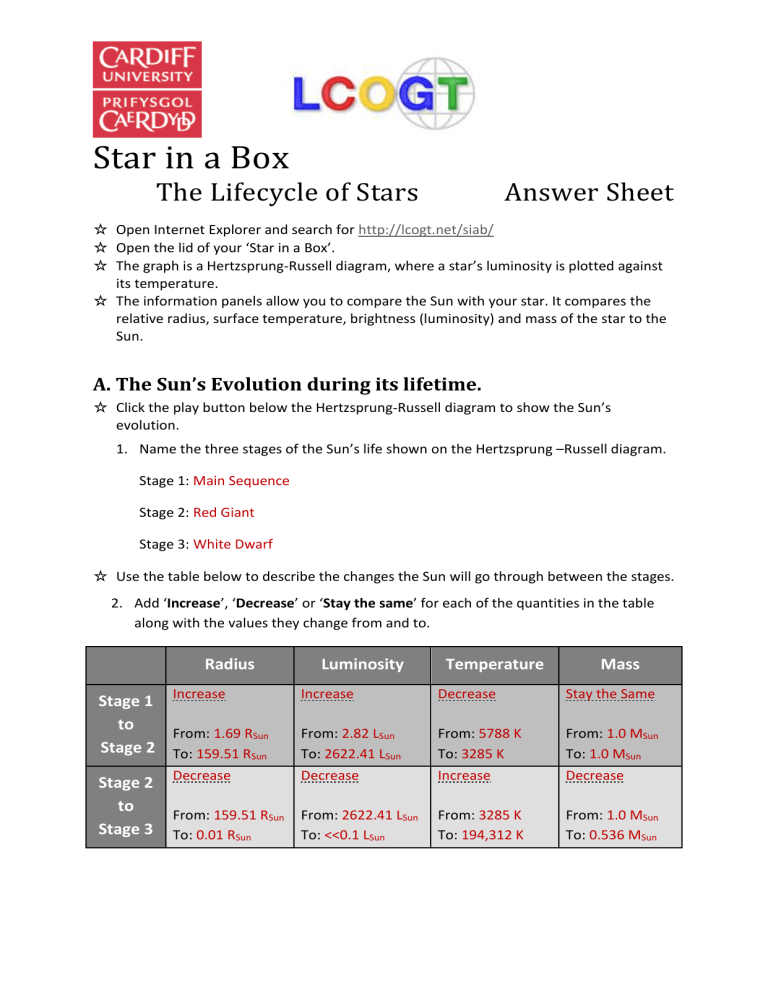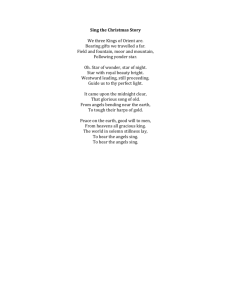Answer

Star in a Box
The Lifecycle of Stars Answer Sheet
☆ Open Internet Explorer and search for http://lcogt.net/siab/
☆ Open the lid of your ‘Star in a Box’.
☆ The graph is a Hertzsprung-Russell diagram, where a star’s luminosity is plotted against its temperature.
☆ The information panels allow you to compare the Sun with your star. It compares the relative radius, surface temperature, brightness (luminosity) and mass of the star to the
Sun.
A. The Sun’s Evolution during its lifetime.
☆ Click the play button below the Hertzsprung-Russell diagram to show the Sun’s evolution.
1.
Name the three stages of the Sun’s life shown on the Hertzsprung –Russell diagram.
Stage 1: Main Sequence
Stage 2: Red Giant
Stage 3: White Dwarf
☆ Use the table below to describe the changes the Sun will go through between the stages.
2.
Add ‘Increase’, ‘Decrease’ or ‘Stay the same’ for each of the quantities in the table along with the values they change from and to.
Radius Luminosity
Stage 1 to
Stage 2
Stage 2 to
Stage 3
Increase
From: 1.69 R
Sun
To: 159.51 R
Sun
Decrease
From: 159.51 R
Sun
To: 0.01 R
Sun
Increase
From: 2.82 L
Sun
To: 2622.41 L
Sun
Decrease
From: 2622.41 L
Sun
To: <<0.1 L
Sun
Temperature
Decrease
From: 5788 K
To: 3285 K
Increase
From: 3285 K
To: 194,312 K
Mass
Stay the Same
From: 1.0 M
Sun
To: 1.0 M
Sun
Decrease
From: 1.0 M
Sun
To: 0.536 M
Sun
3.
Look at the light bulb tab: a.
At which stage in its lifecycle will the Sun be at its brightest?
Red Giant stage b.
How old (in Myr) will the Sun be at this point?
About 10,301.800 million years
4.
Look at the thermometer tab: a.
At which stage in its lifecycle will the Sun be at its hottest?
Just before white dwarf stage b.
What is its maximum temperature?
Maximum temperature 194,312K
5.
Look at the pie chart tab: a.
In which stage of its life will the Sun spend most of its time?
Main Sequence b.
How long will it spend in this stage?
8992.81 Myr
6.
Look at the mass tab:
What happens to the mass of the Sun as it gets older?
It decreases
7.
What type of star will the Sun be at the end of its life?
A white dwarf
8.
What is the total lifetime of the Sun?
12 Billion years
B. Using the ‘Star Properties’ banner, explore the evolution of stars with different starting masses.
☆ Select a different starting mass for your star in the ‘Star Properties’ banner.
☆ Use the Hertzsprung-Russell diagram tab, click play to watch your new stars evolution.
☆ Try out a few different masses then answer the following questions.
1.
Using the Hertzsprung-Russell diagram: a.
Where on the main sequence do the lower mass stars start?
Lower mass stars are towards the bottom right b.
Where on the main sequence do the higher mass stars start?
Higher mass (more massive) stars are towards the top left.
2.
There are three possible outcomes for the final stage of a stars life depending on its initial mass. Name these 3 possible final stages.
White dwarf, Neutron Star, Black hole
C. Follow the evolution of 5 different mass stars.
☆ Complete the table below, filling in a row for each of the different masses.
Hint: You may find it easier to use the data table on the ‘Star in a Box’ to find the exact values.
Mass of
Star
(M
sun
)
0.2
Maximum
Radius
(R
sun
)
0.33
Maximum
Luminosity
(L
sun
)
(Brightness)
Maximum
Temperature
(K)
Name of
Final
Stage
87.78 119,316
Total
Lifespan
(Myr)
White
Dwarf
1, 034, 300.00
1
6
20
200.26
444.02
1,507.30
3,910.21
23,621.09
191,029.31
194,312
434,410
2,123,244
White
Dwarf
White
Dwarf
Neutron
Star
10, 210.26
76.20
9.84
40
1,433.51 425,402.46 132,008 Black Hole 5.48
D. Study the data for the different stars in your table above.
1.
Comparing the temperatures: a.
Which mass star reaches the highest temperature?
The 20 solar mass star has the greatest maximum temperature b.
At what stage in its life does the star reach this temperature?
When it is a Neutron Star
2.
Comparing the luminosities: a.
Which mass star gets the most luminous (brightest)?
The 40 solar mass star has the greatest luminosity (425,402.46 Lsun) b.
Is this the same mass of star that reaches the highest temperature?
No
E. Multiple choice questions.
☆ Circle the correct answer.
1.
What type of star will the Sun become after it leaves the Main Sequence?
Neutron Star Red Dwarf Red Giant Red Supergiant
2.
What main factor determines the stages a star will follow after the main sequence?
Mass Luminosity Temperature Radius
3.
The mass of the star Betelgeuse is much greater than the mass of the Sun, therefore its total lifetime will be
Greater than the Sun The same as the Sun Less than the Sun
4.
Compared to when it joins the Main Sequence, a star’s mass at the end of its life will
Be greater Be the same Be less Depend on the type of star
5.
The Sun will spend most of its life in what stage?
Main Sequence Red Dwarf Red Giant White Dwarf
F. Stretch and Challenge
☆ Find out, using the internet (or books!)…
Why is the maximum temperature of the 40M sun
star less than the maximum temperature of the 20 M sun
star.
Hint: Consider the different stages these two stars will go through during their lifetime, and the properties of the final stages.
Both stars will become supergiants after leaving the Main Sequence. When the core of the star collapses, both stars will explode as a Supernova.
The 40 M sun
star will reach its maximum temperature during the Supergiant stage. After the supernova, the core will collapse to a single point- a black hole. This will have a very low temperature in the nano-Kelvin region.
After the 20M sun
star explodes, it will leave behind a hot, dense, spinning core- a neutron star. It will reach its maximum temperature during the Neutron Star stage of its life.
This means that due to the different stages the two stars go through, the 20 M sun
star will have a greater maximum temperature than the 40 M sun
star.









